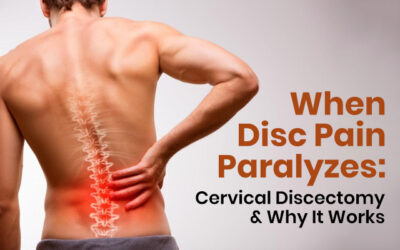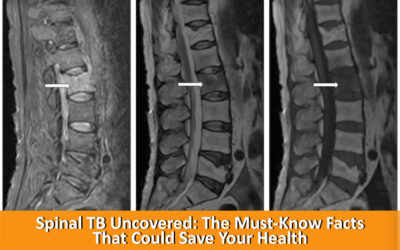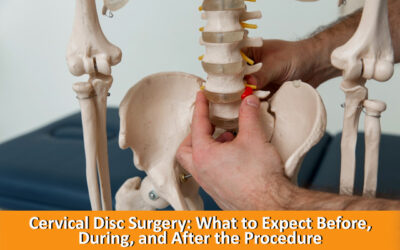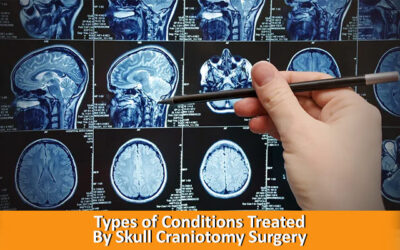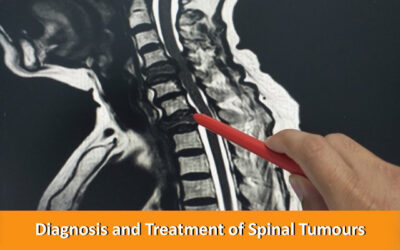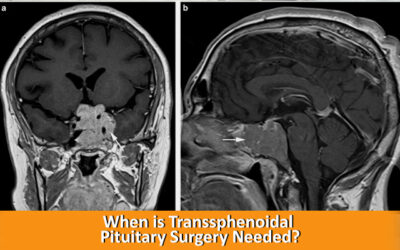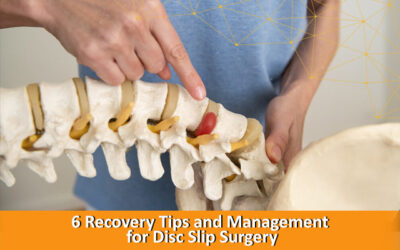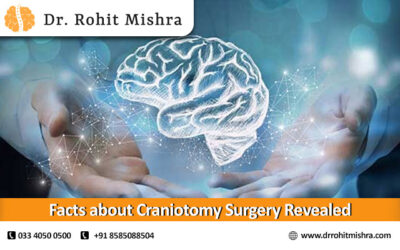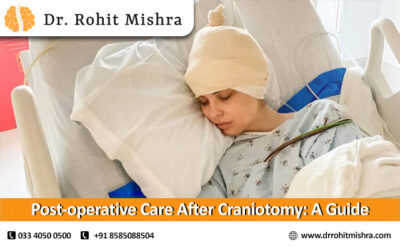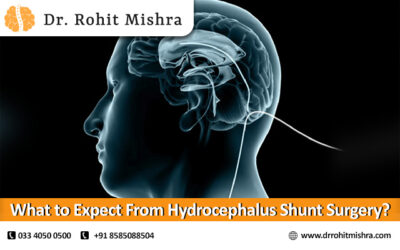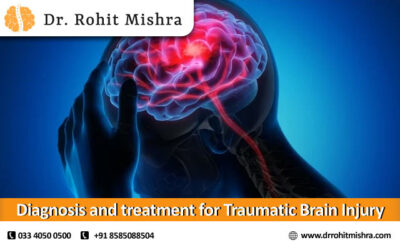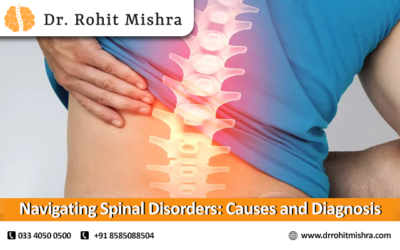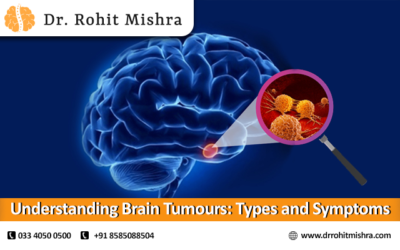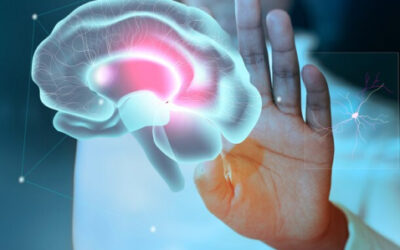When Disc Pain Paralyzes: Cervical Discectomy & Why It Works
Severe neck pain can disrupt your daily life and limit mobility. Consulting Dr. Rohit Mishra, a neurosurgeon in Kolkata, can help you explore treatment options. Here, we will discuss cervical discectomy surgery and how it relieves pain. Understanding Cervical Disc...
Surgical vs. Non-Surgical Head Injury Treatment: Here’s How To Make The Right Choice
Not All Head Injuries Need Surgery — But Some Do Head injuries can be scary. One moment you’re fine, the next — confused, dizzy, or worse. But does every head injury need surgery? Get to know the difference between surgical and non-surgical head injury treatment....
Is your Lower Back Pain due to Lumbar Scoliosis? Valuable Insights
Lower back pain often seems like a minor issue. But sometimes, it hides something deeper — lumbar scoliosis. Many ignore this spinal condition until the pain worsens. Get to know more about back pain related to lumbar scoliosis from Dr. Rohit Mishra, a neurosurgeon in...
Post-concussion Syndrome: Symptoms and Causes
If you’ve had a head injury recently and are still feeling off weeks later, mentally foggy, dizzy, or just not yourself. This lingering discomfort might be something called post-concussion syndrome (PCS). It can sneak up on you after what seemed like a minor bump or a...
Reasons why Persistent Headaches in Children should Not be Ignored
Every parent has experienced the unsettling feeling when their child complains of a headache. While occasional headaches are normal, persistent or severe headaches can be a red flag. It’s easy to brush off a headache as something minor, but when these headaches...
Ways neurosurgeons treat traumatic brain injuries: A closer look
Brain injuries, whether mild or severe, can significantly affect your daily life. The road to recovery can seem long and challenging, but with the right treatment and care, it is possible to recover and regain control of your life. Let’s explore the fastest way to...
Brain surgery in children: Role of pediatric neurosurgery in prioritising safety and healing
When it comes to children, health is always a top priority. For parents, the thought of a child undergoing brain surgery can be overwhelming. However, with advancements in pediatric neurosurgery, children can receive the specialized care they need, ensuring both...
Can Skull and Facial Deformities Be Corrected? Craniofacial Surgery Explained
For some individuals, differences in the shape of the skull or face go beyond appearance; they can affect daily life, confidence, and even essential functions, like breathing or seeing clearly. Whether caused by birth conditions, injuries, or medical issues, these...
Bent Spine, Constant Pain? Learn About Lumbar Scoliosis Treatment
Do you ever look at your posture in the mirror and wonder, “Why is my back curving like that?” Or maybe you’ve been living with constant lower back pain, stiffness, or even a visible lean to one side. If this sounds familiar, you might be dealing with lumbar...
Living with Spinal Cord Injury Pain? DREZ Lesioning Can Help
Living with spinal cord injury pain is not just uncomfortable, it can be life-altering. For many people, even after the original injury heals, the pain does not go away. It lingers, shows up randomly, and becomes a part of daily life. But what if there’s a way to...
The Best Treatments for Brain Tumors? Here’s What Experts Say
If you or someone you know has been diagnosed with a brain tumor, the first thing that comes to mind is, “What now?” That’s completely normal. It’s a scary thought, but the good news is that treatments have come a long way. With the right care, many brain tumors can...
Silent Killer: The Hidden Signs of Brain Tumors You Can’t Ignore
Brain tumors are often called the "silent killer" because they can grow quietly without obvious symptoms—until it’s too late. While some brain tumors are non-cancerous, even benign ones can cause serious problems as they press on different parts of the brain....
Spinal TB Uncovered: The Must-Know Facts That Could Save Your Health
Tuberculosis (TB) refers to a bacterial infection that, when left untreated, can prove to be fatal. Though this condition is often associated with the lung, it can sometimes affect other body parts, such as the spine. Spinal Tuberculosis, also known as Pott’s Disease,...
Signs, Symptoms, and Treatment Options of a Concussion
A concussion is a mild traumatic brain injury that occurs when a sudden blow or jolt to the head disrupts normal brain function. While concussions are common in sports, accidents, or falls, they should never be ignored. Understanding the signs, symptoms, and treatment...
Cervical Disc Surgery: What to Expect Before, During, and After the Procedure
If you're dealing with severe neck pain, numbness, or weakness in your arms due to a damaged cervical disc, surgery might be the best option. Understanding what happens before, during, and after the procedure can help you feel more prepared. Before the Surgery The...
Understanding Head Injuries: Types, Symptoms, and Other Factors
Head injuries are common and can vary from minor bumps to severe brain trauma. Whether caused by a fall, accident, or sports injury, head trauma should never be ignored. Understanding the types, symptoms, and risk factors of head injuries can help in seeking timely...
Lumbar vs. Cervical Disc Issues: Differences and Treatment Options
If you're dealing with persistent back or neck pain, you might have a disc-related issue. But did you know that spinal disc problems can occur in different regions of your spine? Lumbar (lower back) and cervical (neck) disc issues are the most common types. While both...
Head Injury Severity Test: Know When to Connect with a Specialist
Head injuries can happen to anyone, and while some may seem minor, others could be life-threatening. Knowing when to seek medical help is very important, as a delay in diagnosis or treatment can lead to long-term complications. Understanding the severity of a head...
Best Treatment Options for Lumbar Disc Herniation
A lumbar disc herniation, commonly known as a slipped or ruptured disc, occurs when the soft inner core of a spinal disc pushes through its outer layer. This condition often results in back pain, leg pain (sciatica), and mobility issues. The good news? Several...
Types of Conditions Treated By Skull Craniotomy Surgery
Have you ever wondered what kind of issues require skull craniotomy surgery? Let’s break it down in simple terms. A craniotomy is a surgical procedure where a part of the skull is temporarily removed to access the brain. While this might sound daunting, it is a...
Diagnosis and Treatment of Spinal Tumours
Spinal tumours are abnormal growths in or around the spinal cord or vertebrae. While they are rare, these tumours can cause significant health challenges, affecting mobility, pain levels, and even overall neurological function. Early diagnosis and the right spinal...
When is Transsphenoidal Pituitary Surgery Needed?
Transsphenoidal pituitary surgery is a specialized procedure used to remove tumors from the pituitary gland. This small gland, located at the base of the brain, plays a vital role in regulating many of the body’s hormones. When a tumor develops in the pituitary gland,...
What is the best treatment for a traumatic head injury?
Traumatic head injuries are serious and need immediate attention. They can range from mild concussions to severe brain injuries, which may cause long-term health problems. Understanding the right head injury treatment options can help in quicker recovery and better...
6 Recovery Tips and Management for Disc Slip Surgery
Disc slip surgery, or herniated disc surgery, is often performed to reduce pressure on the spinal nerves caused by a displaced or ruptured spinal disc. Though the procedure is effective, recovery requires dedication to achieve optimal results. Here are six essential...
Preparing for Craniotomy: What To Expect Before the Surgery
During a craniotomy, a part of the skull known as the bone flap is removed temporarily to get access to the brain. This surgery helps in the treatment of brain tumors, brain injuries, neurological disorders, and aneurysms. Though craniotomy procedure steps might seem...
Important Diagnostic Tests Before Undergoing a Craniotomy
A craniotomy procedure is often necessary for treating conditions like brain tumours, injuries, or severe neurological issues. Before you undergo a craniotomy, several diagnostic tests are crucial to ensure that the surgery is as safe and effective as possible. Before...
Life After Craniotomy: What to Expect
Undergoing a craniotomy, a surgical procedure to remove part of the skull to access the brain, refers to a significant medical event with far-reaching effects on your life. Whether the surgery was performed to address a brain tumour, reduce discomfort, or treat a...
Facts about Craniotomy Surgery Revealed
Craniotomy is a vital procedure in modern neurosurgery with a multitude of life-saving benefits. Essentially, the procedure involves removing a portion of the skull to access the brain for various medical reasons. Learn more about craniotomy benefits and facts from a...
Post-operative Care After Craniotomy: A Guide
Undergoing a craniotomy—surgical removal of a portion of the skull to access the brain—marks a significant step in managing serious neurological conditions. The immediate postoperative period is essential for a successful recovery. Effective post-operative care is...
What to Expect From Hydrocephalus Shunt Surgery?
Hydrocephalus is a condition where excess cerebrospinal fluid (CSF) builds up in the ventricles of the brain. This fluid buildup increases pressure within the skull, causing headaches, nausea, vision problems and developmental delays in children. A shunt refers to a...
How Does a Minimally Invasive Spine Surgery Work?
Introduction Minimally Invasive Spine Surgery (MISS) has revolutionized the treatment of various spinal disorders by offering a less invasive alternative to traditional open surgeries. This advanced surgical approach utilizes specialized techniques and instruments to...
When is transsphenoidal surgery recommended?
Transsphenoidal surgery refers to a specialized surgical approach used primarily to remove tumours from the pituitary gland, which is located at the base of the brain behind the nasal cavity. This minimally invasive procedure accesses the pituitary gland through the...
Diagnosis and treatment for Traumatic Brain Injury
Traumatic brain injury refers to a disruption in the normal functioning of the brain because of an injury in the form of a blow, bump or jolt to the head. Accurate diagnosis and treatment are important for reducing the long-term impact of a traumatic brain injury....
Navigating Spinal Disorders: Causes and Diagnosis
The spine is a vital human body component, providing structural support and facilitating movement. However, various factors can lead to spinal disorders, causing pain, discomfort and mobility issues. Understanding the causes and diagnosis of spinal disorders is...
Understanding Brain Tumours: Types and Symptoms
Brain tumours are abnormal cell growths in the brain or the surrounding tissues. Depending on their size, location, and growth rate, they can be benign (non-cancerous) or malignant (cancerous) and cause various symptoms. Here, we will explore the different types of...
Cross-Post: Medical Student Tamia Potter Makes History
Our current series on Making and Maintaining a Neurosurgeon discusses how one transitions from student to resident to practicing neurosurgeon.
Gender Imbalance in Neurosurgery: Breaking Barriers
Our current series on Making and Maintaining a Neurosurgeon discusses how one transitions from student to resident to practicing Neurosurgeon. In particular, we…
The Future of Neurological Surgery: Adapting to GME Changes
Until the 19th century, surgical training was haphazard with no standardization. The surgical trainee learned through observation of a mentor and finished.....

